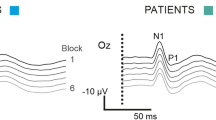Abstract
The occurrence of perceptual disturbances in migraineurs, particularly during the headache-free interval, has been scrutinized rather rarely. This subject was studied via a mail survey in 134 patients presenting perceptual changes before or during their migraine attacks. The patients had to complete a 5-part questionnaire covering history, events before, during as well as after the attack, and the attack-free interval. Sensory alterations during the headache-free interval were not reported by 36.6% of the patients. Alterations of equilibrium and/or spatial orientation, mainly susceptibility to motion sickness, were present in 47.8%, increased sensitiviy to cold or heat in 40.3%, intolerance of tight clothes or being touched in 34.3%, altered visual function in 32.8%, changes in olfactory acuity in 31.1%. These percentages show that these 5 types of interictal sensory disturbances may not be rare in migraineurs. The exact frequency of these symptoms and how they correlate with perictal phenomena, sex, age and disease characteristics has to be further studied.
Sommario
La presenza di disturbi percettivi in persone sofferenti di emicrania, soprattutto durante i periodi di intervallo fra un mal di testa e l'altro, è stata raramente oggetto di studio.
Tale argomento è stato studiato tramite un'indagine per corrispondenza su 134 pazienti che presentavano mutazioni percettive prima o durante gli attacchi di emicrania. È stato chiesto ai pazienti di completare un questionario in 5 parti, riguardante la loro anamnesi e la sintomatologia dell'emicrania prima, durante e dopo gli attacchi, nonché nei periodi di intervallo.
Il 36,6% dei pazienti non ha segnalato alterazioni sensoriali durante i periodi di intervallo dell'emicrania. Alterazioni dell'equilibrio e/o dell'orientamento spaziale, soprattutto la predisposizione alla nausea da movimenti, erano presenti nel 47,8% dei pazienti; un'accresciuta sensibilità al freddo o al caldo nel 40,3%; l'intolleranza di abiti stretti o di essere toccati nel 34,3%; alterazioni nella funzione visiva nel 32,8%; cambiamenti nell'acutezza olfattiva nel 32,1%.
Tali percentuali indicano che questi 5 tipi di disturbi sensoriali fra i diversi attacchi non sono rari nelle persone che soffrono di emicrania. L'esatta frequenza dei sintomi e la loro correlazione ai fenomeni nel corso dei diversi attacchi, l'età, il sesso e le caratteristiche del disturbo dovranno essere oggetto di ulteriori studi.
Similar content being viewed by others
References
Ad Hoc Committee on Classification of Headache of the NIH. Jounal of the American Medical Association 179, 127–128, 1962.
Ansink B.J.J., Danby M., Oosterveld W.J., Schimsheimer R.J., Caers L.I., Amery W.K.:Flunarizine, the vestibular system and migraine. Cephalalgia 5, 205–210, 1986.
Behan P.O., Carlin J.:Benign recurrent vertigo. In: Advances in Migraine Research and Therapy, pp. 49–55. Edited by F.C. Rose, Raven Press, New York, 1982.
Brinciotti M., Guidetti V., Matricardi M., Cortesi F.:Responsiveness of the visual system in childhood migraine studied by VEP. Cephalalgia 5 Suppl. 3, 190–191, 1985.
Dalessio D.J., Polich J., Ehlers C.:Endogenous and psychic determinants of migraine. In: The Prelude to the Migraine Attack, pp. 3–7. Edited by W.K. Amery and A. Wauquier, TransMedica Europe Ltd. Tunbridge Wells, 1986.
Diener H.C., Ndosi N.K., Koletzki E., Langohr D.:Visual evoked potentials in migraine. In Updating in Headache, pp. 101–106. Edited by V. Pfaffenrath, P.O. Lundberg and O. Sjaastad, Springer Verlag, Berlin, 1985.
Gawel M., Connolly J.F., Rose F.C.:Migraine patients exhibit abnormalities in the visual evoked potential. In Advances in Migraine Research and Therapy, pp. 85–91. Edited by F.C. Rose, Raven Press, New York, 1982.
Graham J.R.:The migraine connection. Headache 21, 243–250.
Klee A.:Perceptual disorders in migraine. In Modern Topics in Migraine, pp. 45–51. Edited by J. Pears, William Heinemann Medical Books Ltd., London, 1975.
Kuritzky A., Toglia U.K., Thomas D.:Vestibular function in migraine. Headache, 5, 110–112, 1981.
Nyrke T., Lang A.H.:Spectral analysis of visual potentials evoked by sine wave modulated light in migraine. Electroencephalogr. Clin. Neurophysiol., 53, 436–442, 1982.
Pearce J.:General review of some aetiological factors in migraine. In Background to Migraine, pp. 1–7. Edited by J.N. Cummings, Springer Verlag, New York, 1971.
Raffaelli E. Jr., Menon A.D.:Migraine and the limbic system. Headache, 15, 69–78, 1975.
Winter A.L., Cooper R.:Neurophysiological measures of the visual system of people with “classic” migraine. Abstract Book of the 5th International Symposium of the Migraine Trust, p. 45, London, 1984.
Author information
Authors and Affiliations
Additional information
Dr Waelkens died at the age of 64 after completion of this study.
Rights and permissions
About this article
Cite this article
Amery, W.K., Waelkens, J. & Vandenbergh, V. The sensorium of the migraineur. Ital J Neuro Sci 9, 537–545 (1988). https://doi.org/10.1007/BF02337006
Issue Date:
DOI: https://doi.org/10.1007/BF02337006




